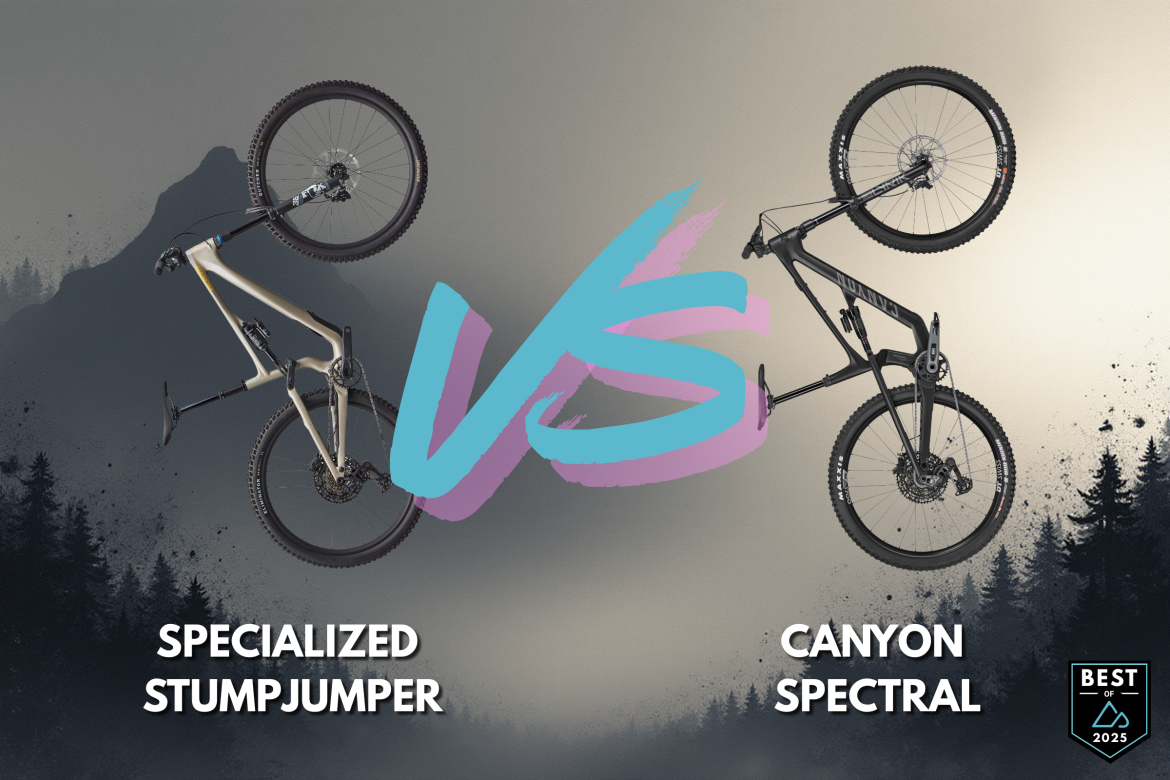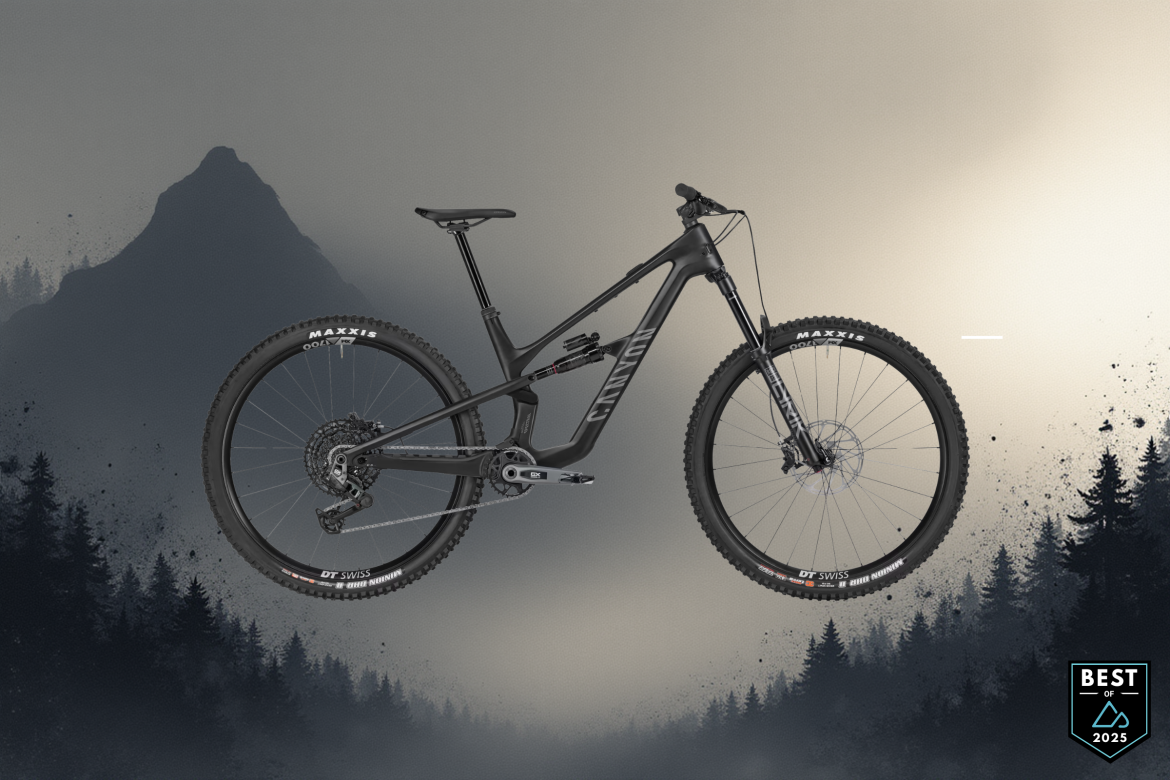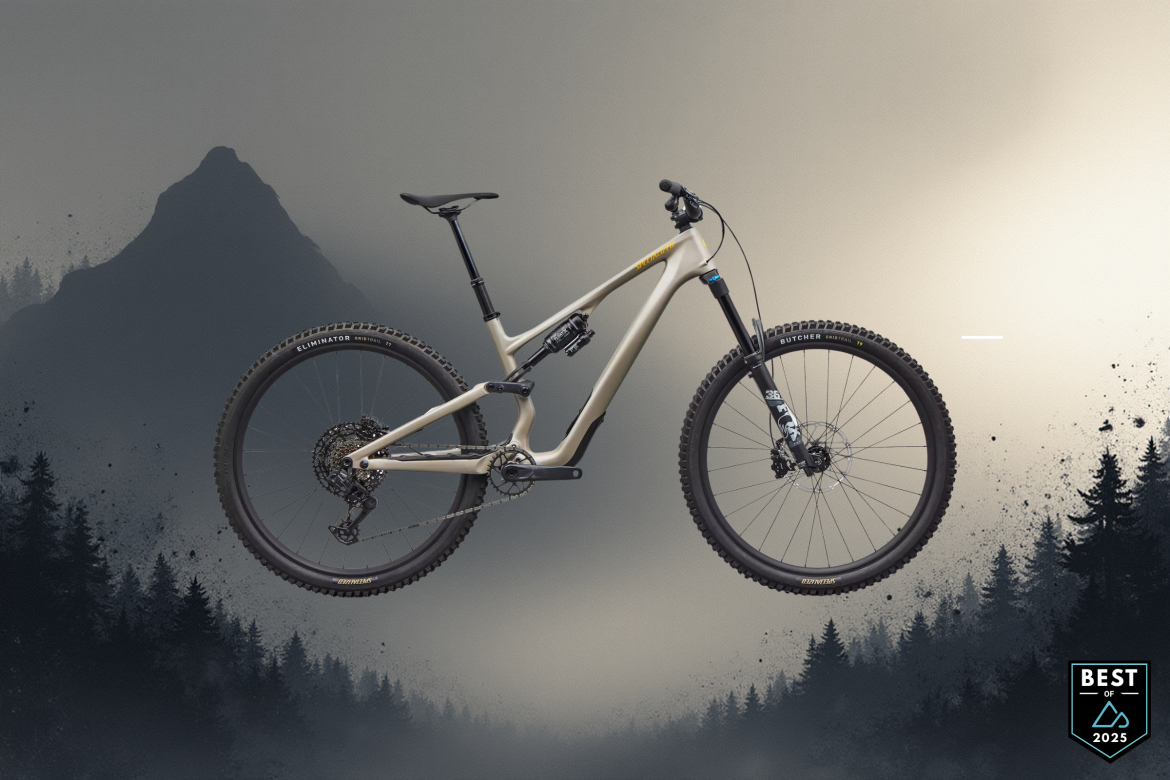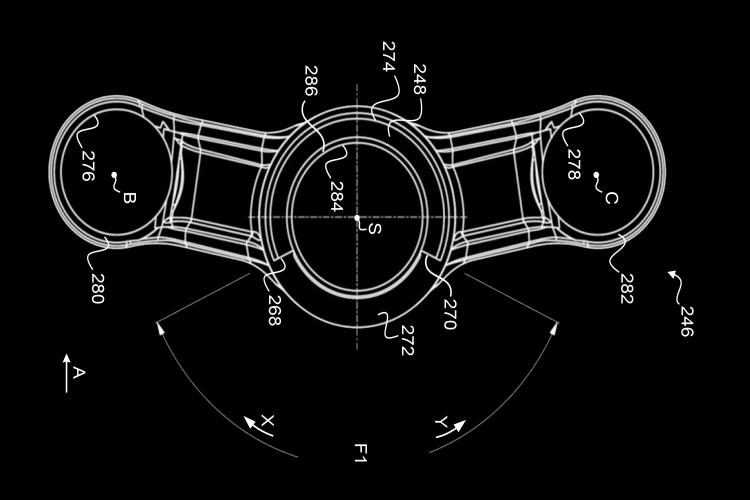
This comparison is a part of the 2025 trail bike of the year tournament. Stay tuned for future matchups and to see which bike moves on to the next round!
When shopping for a new trail bike, two models that consistently pop up in rider conversations are the Specialized Stumpjumper 15 EVO and the Canyon Spectral CF. Both bikes target the aggressive trail/enduro-lite category, but they take notably different approaches to get there. Since component specs can be configured to suit virtually any budget or preference, this comparison mostly focuses on what really matters when choosing between these frames: geometry, suspension travel, and frame features.
| Specialized Stumpjumper 15 EVO Comp | Canyon Spectral CF 8 | |
|---|---|---|
| Suspension travel front/rear | 160/145mm | 150/140mm |
| Drivetrain | SRAM S-1000 Eagle AXS Transmission | SRAM GX Eagle AXS Transmission |
| Suspension | FOX FLOAT 36 Rhythm fork, FOX FLOAT X Performance with Specialized GENIE shock | RockShox Lyrik Select+ fork, RockShox Super Deluxe Select+ shock |
| Geometry (size large* frame) | HTA: 64° STA: 76.5° Reach: 500mm Chainstay: 437mm | HTA: 64° STA: 76° Reach: 495mm Chainstay: 445mm |
| Weight | 33.38lb** | 32.99lb*** |
| Price | $4,999 | $5,099 |
Travel and category positioning
The most obvious difference between these two bikes is their suspension travel, which significantly influences their intended use cases.
The Stumpjumper 15 EVO runs 145mm of rear travel paired with either 150mm (S1) or 160mm (S2-S6) of travel up front. This is an increase from the Stumpjumper 15 that was released just last year, and edges the bike into the “long-travel trail” category—a bike that can handle aggressive terrain but still maintains trail bike efficiency.
The Canyon Spectral opts for 140mm rear travel with 150mm up front across all sizes. While the difference is only 5mm in the rear, that small gap often represents a meaningful philosophical distinction. The Spectral leans slightly more toward the pure trail category, prioritizing efficiency and playfulness over all-out descending capability.
What’s interesting is how travel numbers don’t tell the complete story. Specialized’s patent-pending GENIE shock technology—which combines coil-like suppleness through the initial travel with air-spring progression at the end of the stroke—is designed to make the Stumpjumper’s 145mm feel like significantly more. According to Specialized, the GENIE-equipped Stumpy uses the same amount of travel for certain bump forces as its 170mm-travel Enduro. Whether this translates to real-world riding advantages is subjective, but it’s clear Specialized is betting heavily on shock technology to differentiate its frame.
Canyon takes a more traditional approach with a RockShox Super Deluxe Select+ shock, letting the proven kinematics and geometry do the talking. There’s also a short-travel version of the Spectral, known as the Spectral 125, that’s positioned as a highly capable downcountry-style bike.

Geometry: Similar yet distinct
At first glance, the geometry charts for these bikes look remarkably similar—and in many ways, they are. Both feature modern numbers with 64-degree head tube angles and progressive reach figures that grow to 525mm for the largest sizes of both bikes (Stumpjumper S6 and Spectral XL).
The reach progression tells an interesting story. The Spectral starts 25mm longer in its smallest size (425mm vs. 400mm), but both bikes converge at 525mm in their largest offerings. This suggests the Spectral may be better suited for shorter riders who want an aggressive position, while the Stumpjumper provides a wider range of options across the size range with its six-size lineup compared to Canyon’s five.
Both bikes feature the same standover height — 738mm — for the smallest frame sizes. However, Specialized says the S1 Stumpjumper should fit riders between 59 and 63 inches tall, while Canyon only says the XS size fits riders who are less than 66 inches tall.
Seat tube angles are nearly identical at 76-77.7 degrees, depending on size, placing both bikes firmly in a good spot for efficient climbing positions. Both also feature relatively low bottom brackets—337-340mm for the Stumpjumper and an effective 339mm for the Spectral (36mm drop)—prioritizing stability and cornering confidence over pedal clearance.
Chainstay length is where things get more interesting. The Stumpjumper runs 430-445mm, depending on size, with longer stays in the larger frames. The Spectral maintains a consistent 429mm when running mixed wheels or 437mm with 29-inch wheels across all sizes. Shorter chainstays generally translate to a more playful, easier-to-manual feel, while longer stays improve high-speed stability and climbing traction.

Adjustability: From subtle to significant
Here’s where these bikes diverge most dramatically.
The Stumpjumper 15 EVO offers what Specialized calls “six-way geometry adjustment.” This includes head tube angle adjustment and bottom bracket height tuning. The frame also accepts aftermarket shock links that allow switching between full 29-inch wheels and mixed wheels without affecting geometry. This level of adjustability means a single frame can be transformed for different riding styles or terrain—slacker and lower for bike park days, steeper and higher for technical backcountry climbs.
The Spectral CF provides a flip chip for geometry adjustment and can also run mixed wheels or full 29-inch configurations. However, the degree of adjustability is more limited than the Stumpjumper’s system. Canyon’s approach is simpler and likely easier to set up, but it doesn’t offer the same range of fine-tuning.
Wheel size flexibility
Both bikes embrace the modern trend of wheel size flexibility, but they execute it differently.
The Stumpjumper ships with 29-inch wheels front and rear, with optional aftermarket links available to convert to mixed wheels. The geometry is designed to remain consistent regardless of wheel size choice.
The Spectral comes ready to run either configuration out of the box. The smallest size, extra small, can only be ordered with mixed wheels, while larger sizes ship with 29-inch wheels but can be converted.
Frame features
The Stumpjumper frame includes SWAT 4.0, Specialized’s fourth-generation integrated downtube storage system. This tool-less, flush-mounted system is genuinely handy for carrying essentials without affecting the bike’s aesthetics or performance. The Stumpjumper also features a lifetime replacement guarantee on suspension pivot bearings, up to one set of bearings per year.
The Canyon Spectral CF also has internal downtube storage, and something that Specialized doesn’t offer: KIS steering stabilization. In Matt Miller’s test of the feature in 2023, he said “the biggest rider benefit from KIS in my opinion is on the climbs. KIS helps the handlebars tracking straighter, especially on steep, slower climbs where the bars are more likely to wobble side to side.” Canyon does not offer lifetime suspension pivot bearing replacements.
Both frames use threaded bottom brackets—a welcome feature for maintenance and reliability. And both use industry-standard 12x148mm rear spacing and are UDH-compatible for use with modern electronic drivetrains. The Stumpjumper explicitly requires an electronic drivetrain, which limits upgrade (or downgrade) choices down the line.
The bottom line
These are two excellent trail bike frames that approach similar terrain from slightly different angles.
The Stumpjumper 15 EVO is the more adjustable, higher-tech option. Its GENIE shock technology, six-way geometry adjustment, and 5mm of extra rear travel make it the choice for riders who want maximum versatility and cutting-edge suspension tech. The longer travel also gives it a bit more capability on truly rough terrain.
The Canyon Spectral CF is the more straightforward, value-oriented option when considering the build kit. It delivers modern geometry, wheel size flexibility, and solid construction in a slightly lighter package that prioritizes pure trail performance over enduro capability. The simpler adjustment system may actually be a benefit for riders who don’t want to tinker with their setup constantly.
Ultimately, the choice comes down to your priorities. Want maximum adjustability and the latest suspension technology? The Stumpjumper delivers. Prefer a clean, proven design with excellent geometry at a lower weight? The Spectral makes a compelling case. Both will handle aggressive trail riding with confidence—you really can’t go wrong with either bike.
Voting is closed.
We’ll reveal which bike moves on to round two on November 21 when the winner takes on the winner of the Pivot Trailcat LT vs. the Ibis Ripley.











2 Comments
Nov 7, 2025
Nov 8, 2025